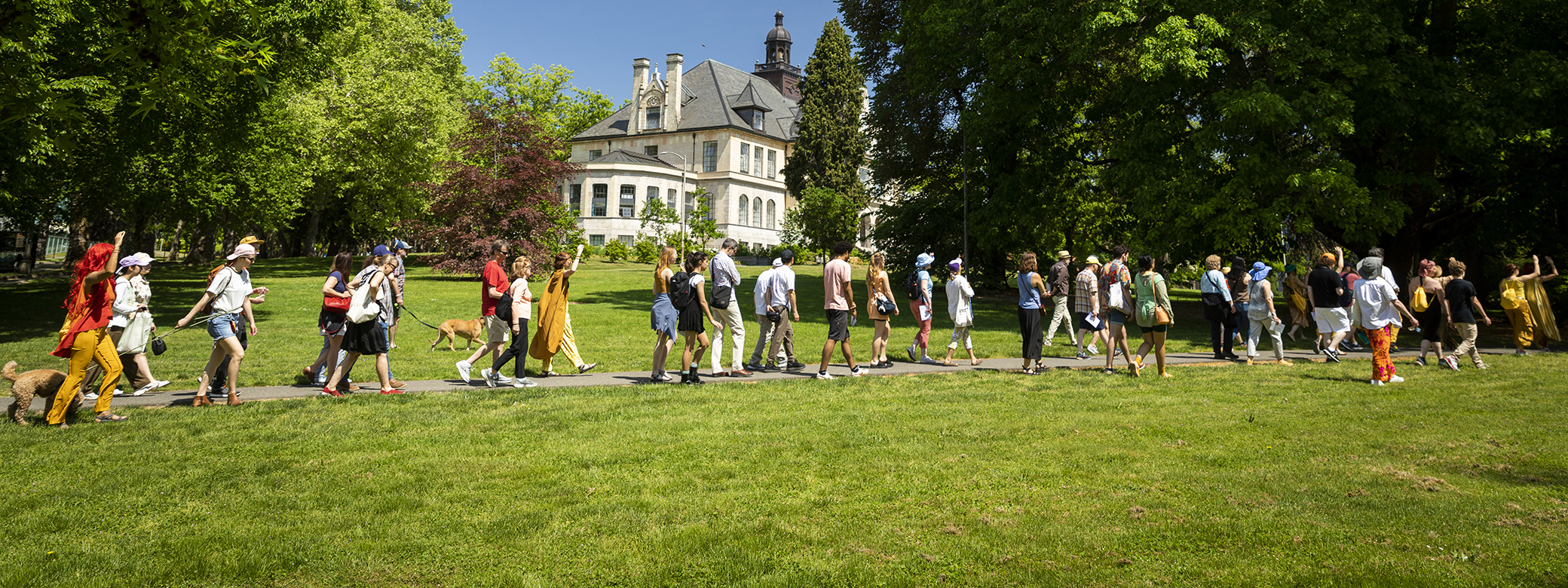
“What if part of being whole means that we choose to see one another’s memories as sacred?”
Artist Daniel Alexander Jones posed that question to a crowd gathered outside the Henry Art Gallery in May, at the start of a one-day event featuring five temporary altars around the University of Washington campus. A processional guided visitors to the five altars, created by artists from the UW and the Seattle community, and then returned to the Henry where an altar by Jones is on display.
The event, “Altar No. 3: I Choose to Remember Us Whole,” was joyful, thought-provoking, and thoroughly original — much like Jones, the visionary who developed the project. Jones’s body of work includes original plays, performance pieces, recorded music, concerts, music theatre events, essays, and long-form improvisations.
For this project, Jones was inspired by the tradition of altar building among cultures in the African diaspora, where altars are a way to connect with ancestors. The tradition has been particularly meaningful for Jones since losing his parents and his artistic mentor during the pandemic.
“I wanted to meditate on the idea of grief as part of our life journey — what happens when a person is shattered into fragments and what it takes to mend that,” Jones says.
Supporting Open-Ended Creativity
Meany Center for the Performing Arts commissioned “Altar No. 3: I Choose to Remember Us Whole,” which was co-presented with the Henry Art Gallery. (Both are part of the UW College of Arts & Sciences.) The project was a departure from Meany Center’s usual offerings.
“This kind of large-scale work with so many campus and community partners and deep, long-lasting collaboration over many months pilots a new paradigm of thinking for us,” says Michelle Witt, executive and artistic director of Meany Center. “This is what open-ended creativity is about — letting artists lead and embracing a very de-centered creative process.”

With such an open-ended process, it helped that Jones already had a relationship with Meany Center. He had been a Mellon Fellow at Meany through an Arts and Creativity Initiative (funded by the Mellon Foundation) and had performed at Meany through a partnership with On the Boards. Then New York Live Arts was invited to curate a performance series for Meany and suggested including Jones in that series. When Meany reached out to Jones, he proposed the altar project. He wasn’t sure how they would respond.
“It was a stretch because Meany had never done anything like that, but they committed to it,” Jones says. “Instead of saying ‘We need another thing like the thing you did before,’ they were genuinely willing to go on a journey of discovery. That, to me, is what made this so special.”
Activating the Processional
When Jones began planning “Altar No: 3: I Choose to Remember Us Whole” 18 months ago, he knew he wanted to involve artists of different generations and practices. Jones and Meany Center invited Valerie Curtis-Newton, Afroditi Psarra, Leon Finley, Althea Rao, and Timothy White Eagle to participate. Some of them Jones knew already; others were new to him. “You can never tell for sure what a person will be like in a process like this,” he says. “One of the things I loved is how wildly distinct from one another they are.”
This is what open-ended creativity is about — letting artists lead and embracing a very de-centered creative process.
Jones also met with Juliet McMains, UW professor of dance, who offered to co-create movements with "activators” who led the processional from altar to altar. McMains brought on Department of Dance lecturer Diana Garcia-Snyder (MFA, Dance, 2008) as her collaborator, and together they created a UW course to bring undergraduate students into the process. They invited others in the community to become activators as well.
“We were given the task to link the altars,” says McMains, “and to dispel the energy from one altar and prepare the energy for the next.” Meeting with the altar artists helped inform their choices, but spending time on the event route was equally telling. “The most important thing I learned from this whole process was how much the space shapes the art and experience,” McMains says.
Five Altars, Five Perspectives
The five temporary altars incorporated themes of memory and wholeness, but the artists explored those themes in vastly different ways. That delighted Jones, who met with the artists together and separately at various points in the planning process but mostly gave them free rein to run with their ideas. He likens the process to jazz, where musicians are connected through a common melody but also given room to improvise.

The first stop for the processional was “Wisdom Walk,” by Valerie Curtis-Newton, UW professor of drama. In the courtyard of the Art Building, Curtis-Newton created a labyrinth that people could enter at different points, with a basket of typed questions at each entrance. Visitors were encouraged to pluck a question from the basket and ponder it as they walked the labyrinth. When they reached the labyrinth’s center, there was a “wisdom book” with blank pages on which to write down their thoughts.
For Curtis-Newton, the altar was an opportunity to encourage the sharing of knowledge between generations. She invited three cross-generational colleagues — School of Drama assistant professors Sara C. Walsh, An-lin Dauber, and Nikki Yeboah — to develop the altar with her. As visitors engaged with the altar, the wisdom book filled with their thoughtful responses to questions like What do you hope comes after? and What do you want those who will inherit this earth after you’re gone to know?
“If the action of our altar was to facilitate wisdom sharing, the book became the actual vehicle for that wisdom to be shared,” says Curtis-Newton. “That you have your own epiphany is wonderful, but it’s also important to share that epiphany with others.”
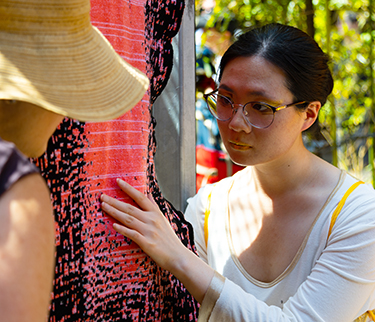
At the next stop, Afroditi Psarra, associate professor of digital arts and experimental media (DXARTS), invited people to engage with her altar, “Altar to Interdimensional Entanglements,” through touch. To reflect on the idea of portals as objects of intergenerational, interdimensional, and celestial connections, she created a series of knitted tapestries depicting portals such as tunnels, caves, and black holes, generated using artificial intelligence (AI). The tapestries hung from metal frames in front of Meany Studio Theatre and produced an ethereal sound when touched, thanks to conductive wires knitted into the material.
From there, the activators passed the façade of Meany Hall, where they paused to interact with the architecture through movement. Along the west side of the building, Seattle artist Leon Finley was waiting at his “Altar to The Death of the Sun.” Between two thin lines of composted soil, Finley posed the question What will you become when the sun burns out? and directed the gathered crowd to turn toward the sun and speak their answers in unison. Their individual thoughts merged into a rousing cacophony.
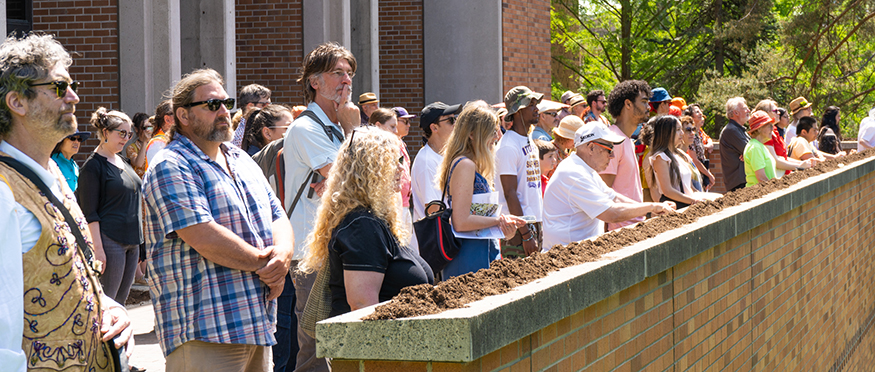
The procession continued to Mercer Court on West Campus, for DXARTS doctoral student Althea Rao’s “Chestful of Whispers.” Rao spoke about the “Mercer Girls” — women recruited to Seattle in the 1860s by Asa Mercer, pioneer and first president of the Territorial University of Washington, when marriageable women were in short supply. After noting that most of the women married and gave birth to new generations of Seattleites, Rao asked those visiting her altar to plant seeds in a section of the UW Farm behind Mercer Court.
The final altar, “Sacrifier Les Vivant,” was created by Timothy White Eagle, a Seattle artist and ritualist who chose to explore the question, How do you surrender the known body? How do you prepare for evolution to a world as yet unseen? White Eagle’s altar, at Upper Rainier Vista, combined ritual with a surreal theatrical experience involving strange and unexpected characters, rich with metaphor — and ended with the serving of firewood tea.

Ephemeral Yet Enduring
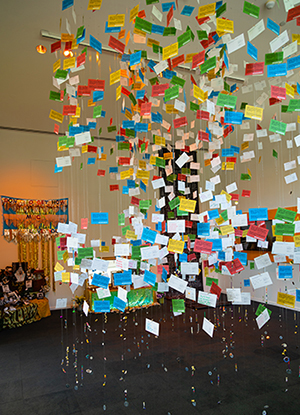
The processional ended where it started, at the Henry Art Gallery. Inside the lobby is an exhibit with a sixth altar created by Jones, which will remain on view through August 6. That altar incorporates hundreds of cards filled out by the public, responding to questions about the sacred nature of memories. “So many people who wrote those cards offered the wisdom of their lived experience,” says Jones. “Often very painful wisdom, but that makes something sacred for all of us.”
The Henry exhibit also includes elements from each of the temporary altars, including the “wisdom book” from Curtis-Newton’s altar and seeds from Rao’s planting ritual at the UW Farm.
When the exhibit closes, little will remain of “Altar No. 3: I Choose to Remember Us Whole.” That’s fine with Jones. More than fine, in fact. “The ephemeral nature of the work is almost the most important thing,” he says, “because it makes us realize that we can’t take for granted the things we’re in the presence of. They may not be here tomorrow.”
The altars may be ephemeral, but for those who created them and for those who attended the processional, their impact endures.
“They gave us an opportunity to really reflect on some big questions together — big questions of life and death and belonging and memory,” says Witt. “It felt immersive and personal and deeply meaningful in ways that are rare in life.”
More Stories
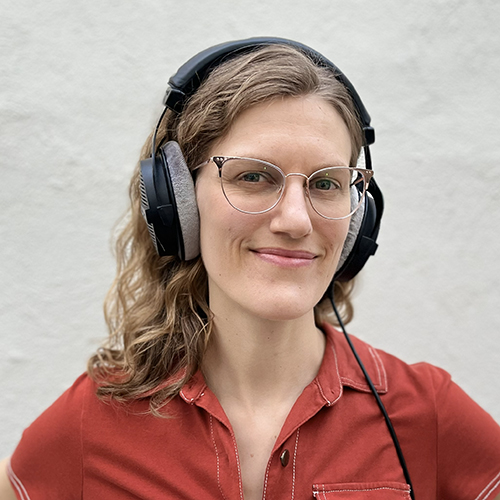
Bringing Music to Life Through Audio Engineering
UW School of Music alum Andrea Roberts, an audio engineer, has worked with recording artists in a wide range of genres — including Beyoncé.

A Healing Heart Returns
In February, the UW Symphony will perform a symphony that Coast Salish elder Vi Hilbert commissioned years ago to heal the world after the heartbreak of 9/11. The symphony was first performed by the Seattle Symphony in 2006.

Need a break from holiday movies? Try these
For those wanting a break from holiday movies, Cinema & Media Studies faculty and grad students offer suggestions.
